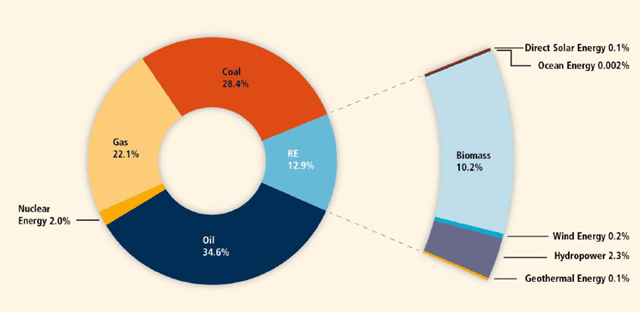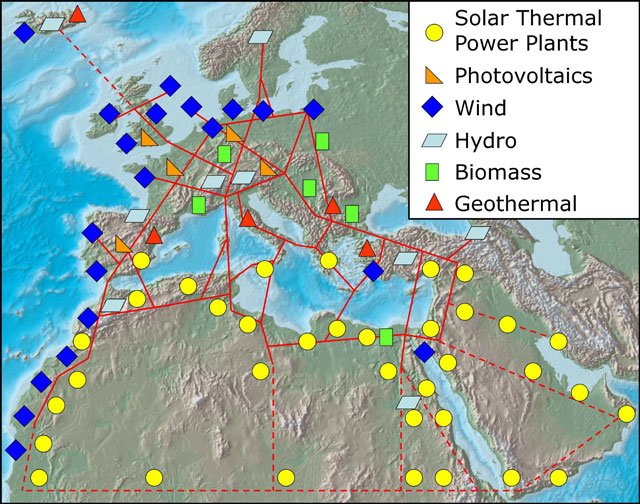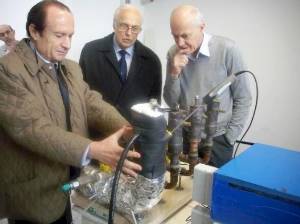A Special Report Renewable Energy Resources and Climate Change Mitigation SRREN by the Working Group III of the Intergovernmental Panel on Climate Change IPCC “presents an assessment of the literature on the scientific, technological, environmental, economic and social aspects of the contribution of six renewable energy resources to the mitigation of climate change. It concentrates “on the role that the deployment of RE technologies can play within such a portfolio of mitigation options.”
The assessment produces a best case scenario projection of 77% of of global primary energy from renewable sources by 2050. The Summary for Policymakers presented the numbers of current Renewable Energy RE sources. A graphic shows the total global primary energy supply of 492 Exajoules for 2008 and its distribution of energy by source.

Biomass contributes the largest share of the RE contribution, but 60% of that comes from “traditional” biomass.
“Traditional” biomass generally means the burning of wood is the primary source of energy for billions of people and contributes to deforestation, loss of wildlife habitat, and poor air quality.
On a global basis, it is estimated that RE accounted for 12.9% of the total 492 Exajoules (EJ) [5] of primary energy supply in 2008 (Box SPM.2) (Figure SPM.2).
The largest RE contributor was biomass (10.2%), with the majority (roughly 60%) being traditional biomass used in cooking and heating applications in developing countries but with rapidly increasing use of modern biomass as well.[6]
Hydropower represented 2.3%, whereas other RE sources accounted for 0.4%. [1.1.5]
In 2008, RE contributed approximately 19% of global electricity supply (16% hydropower, 3% other RE) and biofuels contributed 2% of global road transport fuel supply.
Traditional biomass (17%), modern biomass (8%), solar thermal and geothermal energy (2%) together fuelled 27% of the total global demand for heat. — SRREN
Assuming bio-fuel crops like corn, sugar, and palms are within the other portion of the biomass contribution to energy, then doubling the contribution of this renewable source could generate possibly 8% of total primary energy demand.

Hydropower takes second largest share of RE contribution to primary energy supply.
Hydroelectric power generates 2% of the global primary energy. Suppose that doubling the number of dams globally doubled the hydropower contribution to the total primary energy supply to a 4% share. What effects would this have?

A five-dam project in Chile recently approved will change the Patagonian wilderness landscape by carving roads through wilderness to construct power lines, “drown 14,000 acres, require carving clear-cuts through forests, and eliminate white-water rapids and waterfalls that attract ecotourism.” Here in Northern California, efforts continue to succeed to un-dam the Klamath River, which has decimated salmon populations, though the recent victory by Native peoples, environmentalists, fisherman, and miners has yet to see a timetable for actual de-construction.
A greater percent of RE contributed to electricity alone, with 16% generated by hydropower.
Direct solar energy generated 0.1% of total global primary supply in 2008.
Doubling the contribution of solar energy would produce a 0.2% share, still a miniscule amount of the total. “The technical potential for solar energy is the highest among the resources,” the report stated. Then,
“Factors such as sustainability concerns [9.3], public acceptance [9.5], system integration and infrastructure constraints [8.2], or economic factors [10.3] may also limit deployment of renewable energy technologies.”
All of these choices viable for small scale use. But these traditional RE technologies will need to deeply expand into a finite and sensitive environment disrupting ecosystems and economies with negative effects if they are to provide a primary energy supply.
Renewable energy continues to grow with relatively small gains in total primary energy supply.
Interestingly, nearly half of the new electricity capacity generated from 2008 to 2009 was generated by renewable energies, but it hasn’t made much of a difference in an overall cleaner energy consumption. Primary energy supply is dominated by fossil fuels, and peak oil has changed production and consumption of fossil fuels at all levels.
Renewable energy accounts for just under 13% primary energy supply.
Although, according to the SRREN report, RE capacity continued to grow rapidly in 2009 compared to the cumulative installed capacity from the previous year distributed as:
wind power (32% increase, 38 Gigawatts (GW) added),
hydropower (3%, 31 GW added),
grid-connected photovoltaics (53%, 7.5 GW added),
geothermal power (4%, 0.4 GW added), and
solar hot water/heating (21%, 31 GWth added).
Biofuels accounted for 2% of global road transport fuel demand in 2008 and nearly 3% in 2009.
The annual production of ethanol increased to 1.6 EJ (76 billion litres) by the end of 2009 and biodiesel to 0.6 EJ (17 billion litres) [1.1.5, 2.4, 3.4, 4.4, 5.4, 7.4].
Of the approximate 300 GW of new electricity generating capacity added globally over the two year period from 2008 to 2009, 140 GW came from RE additions.
Bio-fuels increased 50% in one year, but producing this bio-fuel has taken farmland away from food possibly contributing to higher food prices. Yet it’s still only a mere 3% of global transport fuels.
The report states that wind energy, which in 2008 provided 0.2% of total global primary energy, increased capacity globally by 38 Gigawatts, a 32% gain in 2009. Solar power increased by 53%. But when the share is still less than 1% of total power generated, the gains are not so effective overall.
The SRREN summarizes the various scenarios for RE growth.
“A significant increase in the deployment of RE by 2030, 2050 and beyond is indicated in the majority of the 164 scenarios reviewed in this Special Report[11].
In 2008, total RE production was roughly 64 EJ/yr (12.9% of total primary energy supply) with more than 30 EJ/yr of this being traditional biomass.
More than 50% of the scenarios project levels of RE deployment in 2050 of more than 173 EJ/yr reaching up to over 400 EJ/yr in some cases (Figure SPM.9).
Given that traditional biomass use decreases in most scenarios, a corresponding increase in the production level of RE (excluding traditional biomass) anywhere from roughly three-fold to more than ten-fold is projected. The global primary energy supply share of RE differs substantially among the scenarios.
More than half of the scenarios show a contribution from RE in excess of a 17% share of primary energy supply in 2030 rising to more than 27% in 2050. The scenarios with the highest RE shares reach approximately 43% in 2030 and 77% in 2050. [10.2, 10.3]”
We will have to double the power generated by a mix of RE sources many times over to reach the highest projection of 77% of our energy supply from RE, or, drastically reduce what we are currently using. And 27% of primary energy supply coming from RE is too little too late. Scaling up the supply of RE technologies such as biomass, hydro and solar have broad impacts that will inhibit this ability to grow.
Nevertheless, assuming there is no “technical barrier”, then it’s possible to continue to make these gains. Given these gains though, the ease of integrating renewable energy resources into existing systems of fossil fuels “varies” and is generally site specific “depending on region, characteristics specific to the sector and the technology.”
“As infrastructure and energy systems develop, in spite of the complexities, there are few, if any, fundamental technological limits to integrating a portfolio of RE technologies to meet a majority share of total energy demand in locations where suitable RE resources exist or can be supplied. However, the actual rate of integration and the resulting shares of RE will be influenced by factors, such as costs, policies, environmental issues and social aspects. [8.2, 8.3, 9.3, 9.4, 10.2, 10.5]“, the report states.
“Costs associated with RE are expected to go down” according to the report. But it appears that costs given do not take into account several factors.
“The levelized cost of energy represents the cost of an energy generating system over its lifetime; it is calculated as the per-unit price at which energy must be generated from a specific source over its lifetime to break even. It usually includes all private costs that accrue upstream in the value chain, but does not include the downstream cost of delivery to the final customer; the cost of integration; or external environmental or other costs. Subsidies and tax credits are also not included.”
One of those costs is associated with transporting energy throughout a grid as in the transmission of centrally-generated electrical energy.

New RE sources require investment in next-generation grid.
Our current infrastructure of power delivery was built by a previous era for a specific technology of hydrocarbons burned at a central location in great quantity to generate electricity that is then carried over long distances to power cities, suburbs, and industrial parks. Neglect, coupled with the patchwork nature of joining technologies together from previous centuries, have left the US electrical grid failing in its attempt to provide over-capacity production.
In “Northwest power surplus may halt wind energy“, the Associated Press’ Tim Fought reports that surging rivers from record rain in the Northwest US have hydroelectric dams at maximum production of electricity that they effectively can’t stop without flooding regions upstream, and apparently cannot sell.
The Bonneville Power Administration has announced “its intentions to curtail wind power until the grid has more capacity, in a move likely to cost the industry millions of dollars.” They have “run out of capability to sell the surplus electricity, store the water or shut down gas, oil, and nuclear plants – leaving wind farms the unfortunate victims.”

Clash of technologies from previous eras impedes deployment of new RE sources.
Many of the wind farms in the Northwest US were built using programs that provide tax credits – only if the operation is producing electricity. Not operating over a three-month period could cost wind farms “as much as $50 million.” If forced, these utilities that use wind farm energy will litigate over “antitrust and market manipulation laws”, the AP report continued. “The action reflects difficulty in integrating the young wind industry into a power grid that dates to the Northwest dam-building campaign that began in the Depression and kicked into high gear after World War II.”
This decision follows a Northwest Power and Conservation Council study that estimates wind power could more than double by 2025, according to another AP report “Northwest wind power could double, cause grid problems“. The council is charged by the President with “developing long-term power plans that balance the region’s energy and environmental needs”.
Wind power in the Pacific Northwest can currently “generate a peak output of about 6,000 Megawatts, or the equivalent of 15 good-size natural gas-fired power plants …… most added in the past five years” and could add “another 5000 to 10,000 Megawatts of wind capacity by 2025.”
I want to believe that renewable energy can be a primary energy source, but rapidly deteriorating world affairs have not yet swayed the biggest consumers to forsake hydrocarbons and adopt renewable energy. Nor has it stopped the developing hardware infrastructure under construction elsewhere. Fossil fuels have a century of history and built a colossal reality of cement and steel. The numbers for RE contributions are low and successive doublings of output from RE seems unlikely.
There is a viable alternative to traditional renewable energy.
Breakthroughs in low-energy nuclear reaction LENR science have achieved a major advance in power generation technology. Clean, energy-dense commercial devices based on LENR are set to enter the market, perhaps within the year.
LENR energy reactors create power using small amounts of hydrogen and metals like nickel, palladium, and others, both plentiful on Earth to create large amounts of energy, much more than burning hydrocarbons. One of the main components in H2O or water, there is enough hydrogen in the oceans to provide global energy for tens of millions of years. Metals are also abundant over the planet. Nickel is the fifth most common element on Earth, including the Earth’s core of iron and nickel.

This ultra-clean technology could replace radioactive nuclear fission assemblies one-for-one generating power at a centralized location and delivering at a distance, but a new 1 MW LENR reactor called the Energy Catalyzer “is relatively small, being only 3 x 3 x 2 meters” making the big attraction to LENR reactors the ability to be off-grid, allowing both communities and individuals an independent, sustainable lifestyle with greater local control over their own energy supply.
Currently, there is a non-0% contribution from LENR reactors to global primary energy supply, for somewhere in the world, there are purportedly 97 Energy Catalyzers steaming forth, and there are many more labs around the globe testing LENR reactors of their own.
In the space of twenty years, a digital revolution occurred across the planet. We believe, whenever the first commercial devices are available, that the energy revolution has the potential to transform our world with clean energy in less than half that time, and most certainly well before 2050.
Cold Fusion Now!
Supporting Links:
IPCC publishes Special Report on Renewable Energy Sources and Climate Change Mitigation Special Report on Renewable Energy Sources and Climate Change Mitigation’ (SRREN)
National Geographic blog When is objectivity not enough?
Industrial Fuel and Power blog Brazil in hot water
Between the Poles European Smart Grids Will Require 500 Billion Euro
Bonneville Power Administration Wind Power
Pure Energy Systems News Ampenergo Amps Up Rossi’s Energy Catalyzer in America

Re metals for E-Cat. Palladium is not in plentiful supply & is a reare earth metal?.
Cheers John M
Good piece Ruby.
Firm grasp of our predicament.
I have taken the liberty of cross linking it to Chrismartenson.com
I shall suppress my excitement with a nice cup of tea.
I don’t think anyone here has truly got a grasp on the implications of this little discovery.
Because of the strong correlation between energy consumption and population growth we will have to leave the planet. Soon there will be orders of magnitude more people living out of the gravity well than on the surface.
Arthur Robey
Posted in the Journal of Nuclear Physics this morning.
Wladimir Guglinski
May 19th, 2011 at 8:52 AM
Dr. Pietro Cambi
The confirmation of Rossi’s technology by an university was important one year ago, so that to show to investors that Rossi’s technology really works. That’s why the confirmation by the Bologna University was crucial.
As the E-Cat is already going on the market, it means that it’s working. So there is no need any confirmation by any university.
There is in general a belief that something can work only when it is confirmed by an university. The scientific community used along the 20th Century such belief in order to fool the people, by convincing them that many experiments which defy the prevailing theories cannot be taking seriously in consideration because they had no confirmation by universities.
But the own universities refused to repeat the experiments.
By this way they have created a vicious circle:
– all the peer review journals refuse to publish the paper describing the experiment, because it violates some principles of current theories.
– all the universities refuse to repeat the experiment, because it was not published in any peer review journal
– so the experiment cannot be taken seriously, because it was not published in any peer review journal, it was not replicated by any university, and so its results were not confirmed.
Tesla’s inventions in the field of free energy are an example.
It seems such conspiracy of the academics against the scientific method will end in 2012.
A good and truthful report on the current state of academic “science”
George, You are totally on top of the Ecat story. I appreciate your posting the news here. I can’t keep up!
Ruby
John, Palladium is expensive, but not a rare earth element. But other metals work too. Nickel will be used because it’s cheaper. After the theory is worked out, it’s possible that other materials could be designed to allow the “nuclear active environment” and produce the effect.
Arthur, I see your posts on ChrisMartenson!
I am so down with the space travel option. Either, lots of people must cease to exist, and we reduce growth, or, we leave the planet. Even with cold fusion, the planet cannot sustain any more people. It breaks my heart to see the forest and wildlife continuously reduced.
No one knows how this energy thing is going to work out, but we sure need something fast.
In the meantime, I shall find a moment of comfort whenever your waggish thoughts appear.
Ruby
Relax Ruby,
No one is going to force you off the surface of the planet.
However, the eponential growth equations show that now the stars are inevitably ours for the taking.
There is a truly infinite bounty of real estate up in 3 Space.
The only constraint is the speed of light.
It is to be expected that humans in their present form will hold it to be axiomatic that we will live on the surface of other bodies. But that will change as soon as we discover the advantages of not being constrained by gravity.
This dark energy conundrum has been shown to be real. It is an anti-gravity force and not a failure of Einstein’s equations. Now, I wonder if we will be able to control that?
I am an I2a (p37.2) We have been expanding into new territory since the year dot. It is what we do.
Arthur, If I do get forced off the planet, I hope its in a HUGE spaceship and not one of these tiny cans – I’m seriously claustrophobic!
But given some room to “breathe”, I’d be first in line for a LENR-powered spaceship ride. I wonder if Defkalion is contracting with Virgin Galactic yet…
Swooping by flying by a “volcano” on Io, swoopin by Saturns rings, dropping off for a spin on Pluto, wow. beyond that, the emptiness might be too much for me..
Do you have an easy to understand for beginners link to I2A(p37.2)? I don’t know what that is, and a cursory search is loading too many details for those already in the know. Email me at ruby (at) coldfusionnow (dot) org. It looks interesting.
Perhaps this explanation will help:
http://www.familytreedna.com/understanding-haplogroups.aspx
Thanks, this is easier to understand. I won’t try to remember all the letter-codes, though.
I’m amazed y’all get your DNA tested like this!